Western Nurse






















Book an ANF holiday unit at Kalbarri today for a great spring getaway.
Bookings from $46 a night. Available to all ANF members. Bookings, prices and information through iFolio.
I would like to open with saying a sincere thank you to all ANF members who attended the 2023 ANF Legal Conference in June and the Health and Safety Conference in August. Both events were huge successes, fully selling out with nearly 1,000 ANF members collectively in attendance.
I would also like to sincerely thank all our knowledgeable and dynamic speakers wholeheartedly. We saw an array of informative and inspiring presentations by all those who spoke. I have been overwhelmed by the huge number of positive messages we have received from many of you who attended the events.
As I highlighted in my last State Secretary’s Report, the ANF, and its members have been through a lot over the last two years. Dealing with the effects of COVID on the WA Health system and the nurses and midwives who work within it along with a long period of wage freezes and funding cuts that have worsened the working conditions for nurses and midwives right across the state. We continue to engage in EBA negotiations with the State Government with the hope we will see an adjustment in wages and conditions for nurses and midwives under Roger Cook.
The ANF has consistently bargained in good faith and will continue to do so, working toward dynamic ways for us to achieve the 5 percent pay rise you all need. If Premier Cook is truly committed to fixing WA’s health system, it will also take a new dynamic approach from him as a leader. Rehashing Mark McGowan’s hard-line stance will not work, neither economically nor politically. To move this process along, the ANF has begun the next chapter of our campaign.
You would have undoubtedly noticed our EBA Public Sector Campaign has moved into the next phase. We have a large array of radio, streaming, newspaper and essential social media adverts now out in full force, state-wide. We are hoping to gather as much support from you as well as members of the public to reach the 5 percent deal, keeping in mind the next Public Sector EBA is due to be negotiated in 2024. By this time, we want to be in a prime position to be able to provide the best deal for our members, as we always strive to do. I assure you, my team and I are working tirelessly in order to secure the best outcomes for ANF members, always. But that does not mean the challenges in the meantime are going to go away soon, though we are fighting for better pay and conditions.
The hardships do not stop, and we cannot continue to make up for the State Government’s lack of commitment to safe staffing levels, fair pay, and positive workplace conditions to the point where nurses and midwives are feeling forced to fill the critical staffing shortages through things such as triple shifts. The newly sworn in Cook Government has a lot of leg work to do to not only rebuild our ailing health system, but also the trust of their health staff.
In the coming weeks and months, I plan to visit ANF members far and wide. Much of the time we see our regional areas neglected and ignored, the ANF does no such thing. I hope hear from each of you. I have recently been down to parts of the Southwest WA, the Wheatbelt, and in July I spent a few days in the Kimberley where I visited members throughout the region.
I do not aim to be a "one and done" State Secretary. As I said, I will look to go to the furthest reaches of WA however many times it takes to see you all. Of course, I am only an email or phone call away as well at janet.reah@anfiuwp.org.au and 0448 824 617
 Janet Reah
Janet Reah
Along with providing nurses and midwives with the best and broadest support, the ANF is working hard to ensure this support is affordable for all our members.
The ANF caught the attention of other unions last year when it announced a remarkable 27 percent reduction in fees. The ANF had previously maintained the same fees for 18 years which meant ANF members paid less than half the fees of other unions. The further 27 percent reduction meant ANF fees were closer to a third the cost of other unions.
At the time ANF Secretary Janet Reah said the reduction in fees highlighted the ANF Council’s understanding of the growing financial pressures of the rising cost of living. She emphasized the ANF’s commitment to addressing this concern.
The ANF Council has now committed to maintaining those same affordable fees for a further 12 months, meaning Registered Nurses will pay $5 a week, and Enrolled Nurses and carers will pay $4 a week.
Ms Reah spoke to the Western Nurse after the Council’s decision, expressing that the ANF Council recognises the common desire among ANF members and the wider community to cut down on household expenses.
This move, she stressed, sends a clear message that the Council is taking proactive steps to support nurses and midwives during these challenging times in Western Australia.
“The ANF Councillors are regular working nurses and midwives who face the same cost-of-living pressures as every other ANF member and so they are keen to help wherever they can,” Ms Reah said. Keeping the fees low while at the same time continually expanding services is evidence of their commitment and hard work during these difficult times.”
She pointed out that the ANF’s current focus involves three crucial aspects.
Firstly, advocating for improved wages that align with inflation rates, ensuring members’ financial stability. Secondly, expanding the range of services available to ANF members to enhance their membership experience.
Lastly, she emphasised the importance of maintaining the lowest possible ANF fees, making it easier for nurses and midwives to continue their affiliation with the ANF.
Ms Reah also pointed out that even in the face of hefty fines from the WAIRC and the potential creation of an ANF political party to advance the interests of ANF members, the fees remain less than a third of the other WA Unions who don’t have half the services provided by the ANF.
ANF Senior Vice President Loreta Murphy said COVID-19 and cost of living pressures called for the common-sense fee freezes.
“The ANF’s membership price freeze was a necessary act in an uncertain time,” Ms Murphy said.

“With the hardships the cost of living crisis and COVID have put everyone through, to do so while offering double the services other unions don’t is proof this Council under Janet Reah is well and truly doing great work for our members.
"I’m proud to be on the Council as your Senior Vice President and will always look out for our fantastic membership.”
ANF Councillor Megan McDermott echoed the same sentiments, highlighting the rarity of the ANF’s prices among an economicallyinflating world.
“During these most challenging health, housing and affordability issues we all face, it’s a rare find to be given a financial reduction of any kind,” Ms McDermott said.
“The ANF continues to remain true to their word. We are here to work for and on behalf of all our members right now, tomorrow and into the future.
“The ANF are proud to have reduced member fees and continue to do so in an unprecedented manner not just through COVID but continuing that forward for now.”
ANF members are encouraged to call the ANF’s improved enquiry line for help and support with their general membership and Helpline questions.
The changes to the enquiry line follow a review led by ANF State Secretary Janet Reah to ensure all ANF members have access to an easy-to-use service which will further compliment the recent improvements to the ANF Helpline and existing services through iFolio.
Our new menu options will direct members to the relevant area within the ANF quickly and efficiently. Members will also be given the option to receive a callback if no ANF officer is immediately available.
Ms Reah said the review into the ANF telephone enquiry line was the result of feedback from ANF members.
“We listened to our members and the changes we have made to this service reflect our ongoing dedication to providing members with the support they need,” Ms Reah said
“If you have a question about your membership or about accessing the ANF Helpline, our staff will be on hand to help. Every call is important to us.
“I want to thank all our members who took the time to provide constructive feedback on the enquiry line. Your input has gone a long way in helping us improve services.”
To book an appointment with an industrial officer, members are still encouraged to make bookings via our improved Helpline service via iFolio.
We are here to help. If you have a general enquiry about your membership or about Helpline, call 6218 9444 today.

Those of you who are engaged with the outside world (or don’t live under a rock) would have noticed over the last few weeks that the ANF have begun a state-wide rollout of advertisements for our Public Sector EBA campaign.
This new, revitalised phase – a continuation of last year's fantastic energy and support – is the latest chapter in the ANF’s advocacy for our members.
We have ads for everybody. We have heavily hit the airwaves with radio and streaming, which include the words and personal stories of ANF members, brought to the public so they can hear just how bad it is. We also have targeted traditional newsreaders with newspaper ads, as well as the very essential online and social media advertising for a modern approach to advocacy.
This carefully constructed campaign will give us the jumpstart needed to garner the energy and support from yourselves, as well as members of the public, to match last year's campaign.
The Cook Government has had a rocky start. Out of the gate they have been hit with policy scandals and more health blunders, continuing the legacy of WA Labor’s poor health management.
The way to fix this poor handling is not shiny new hospitals or equipment, but rather recruiting the nurses, midwives and carers needed to staff those facilities in the first place.
While WA Labor has increased the health budget to $11.8 billion in 2023-24 up from $8.8 billion in 2017-18, not a cent of that has been committed to solidifying WA’s competitiveness with other states when it comes to salary offerings, with WA nurses and midwives now being the lowest in Australia.
While Health Minister Sanderson spends her time making announcements for new facilities that never see the light of day, WA Labor cry poor and claim they don’t have the funds to help our workforce in meaningful ways.

That is why this ad campaign is so essential to our fight. History has shown when the public sector falls in line with competition, the private sector will follow, making results better for all ANF members down the line.
Thank you all for your kind words over the last few weeks since this campaign began, we cannot let the energy dip.
The Cook Government’s inability to move on the Public Sector EBA negotiations are also a reason we ran the poll in mid-August on whether the ANF should start a political party. I believe this avenue could open a great deal of possibilities for the future of advocacy.
By having an experienced nurse or midwife in State Parliament, we can have a real say and an effect on policy that can help you, our health system, and all Western Australians, as well as keep the elected Government of the day accountable and transparent.

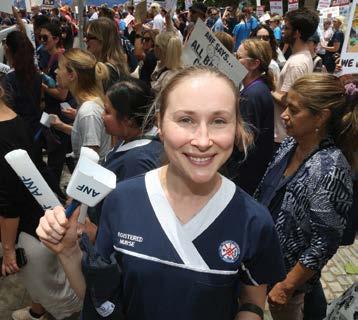

At the time this article has been written the poll is tracking around 85 percent in favour of creating a party and by the time you are reading this the ANF will likely have made a decision based on the results.
It is fantastic to see such a great number of participants getting involved on deciding the future of nurse/midwife advocacy.
If you have a story you want to get on the airwaves to help enhance our campaign, please get in touch at anfsecretarywa@anfiuwp.org.au
We need a 5% payrise our nurses to make WA competitive again.It has been great to see so many nurses and midwives advocating for their futures.
The current health system is bereft of the supports and structures necessary for nurses to properly care for patients. As health professionals, nurses aspire to provide patients with the standard of care we not only want to provide, but which our friends, family and the community deserve.
As a consequence of being asked to do more with less, Australia’s "gold standard" of health care, the envy of much of the world, is now under threat. And with the ominous looming demise of our health system and the consequent pressures on health professionals, particularly nurses, comes the risk of error. But these mistakes are often not the product of recklessness or negligence, but rather simply fatigue or overwhelming workloads. The need for legislative protection is obvious.
“Safe Harbour”, a potential provision of law, could ensure that certain nursing conduct would not violate a given rule and could provide the necessary protection from a penalty or civil or even criminal liability.
No doubt many, if not all of us empathised with the nurses involved in the Aishwarya Aswath case. Nurses whose repeated pleas for help over a six month period fell on deaf ears. Nurses who were not supported by hospital management and were failed by inaction. These nurses were stretched, each being required to perform multiple roles that fateful shift. When news of the tragedy hit the media, nursing colleagues were repeatedly heard to say, “there but for the grace of God go I!”
What has changed in the Australian healthcare landscape that we need a law to protect us from our human error?
As nurses, especially in Western Australia, we face a long list of challenges that include:
• No enacted nurse to patient ratios – and no timeline of when they will happen
• Global staff shortages – WA Nurses are the lowest paid in the country, we are not the first choice for nurses coming to work in Australia
• ‘Baby-boomer’ retirements. An aging workforce - nurses retiring or choosing to retire early?
• A 42 percent novice staffing profile (traditionally 15 percent) (Wakefield et al., 2022; Mannix, 2021).
• Newly qualified staff not ‘workplace ready’ (An American study reported only 23 percent of newly qualified nurses could execute required competencies - Kavanagh & Szweda, 2017) and high attrition rates of newly qualified staff (Wakefield et al., 2022)
• The impacts of COVID-19 including fatigue and burnout (Ahorsu et al., 2021; Galanis, et al., 2021) which leads to experienced staff leaving the profession
• Ever increasing patient acuity requiring nurses to manage clinically complex and often deteriorating patients (Wakefield et al., 2022).
• Increasing population size and ageing communities placing extra demands on nurses (Walker and Clendon, 2018).
Perhaps the saddest reality we face as Western Australian nurses, is the stark realisation that there is no nursing “cavalry” coming over the horizon anytime soon.

The best way to describe our current nursing workforce, in all its representations is: professional, resilient, hardworking, committed, exhausted, stressed and brave. Of all these descriptions “brave” should resonate the most. Every day, shift after shift, nurses agree to come in early to work to help cover a dangerous shortfall in staffing levels. We agree to do double shifts, which sadly have become the norm, and for which no one even raises an eyebrow. Now, more horrifying, is the occurrence of triple shifts. The Canadian Centre for Occupational Health and Safety (2021) reported that 21 hours awake is equivalent to a blood alcohol content of 0.08. Whilst 24 to 25 hours awake is equivalent to a blood alcohol content of 0.10. Those doing a “double” from a “late” into night duty may be driving home 26 hours after they last slept.
So why do we work these dangerous long shifts? Ironically, our Health Minister recently suggested “nurses should not be allowed to do them”, suggesting nurses are happily lining up to take advantage of the extra work. Nothing could be further from the truth. Quite simply, we do them because no one else is available. We do them because if it were our loved one coming out of surgery or intubated in ICU, we would want a nurse at the bedside. The alternative is not an option.
Just like the PCH emergency department nurses caring for Aishwarya, many WA nurses feel overwhelmed. However, if nurses are brave, then the government needs to be brave too. The risk of mistakes is a consequence of working in these environments. The blame falls entirely at the feet of government. We sacrifice time with our friends and family, we place unnecessary strain on our own health, and we risk our registrations should we make a mistake. Safe Harbour regulations would give us the reassurance to work in environments where any mistake would be considered and reviewed in light of the exceptional circumstances that might apply. Safe Harbour allows us to get on with caring for patients whilst recruitment and patient ratios are pursued with vigour.
ANF Senior Vice President Loreta MurphyRead this article and complete the quiz to earn 1 iFolio hour
Read this article and complete the quiz to earn 1 iFolio hour
Pressure injury is a largely preventable medical condition. However, it is still a commonly occurring problem around the world, with special patient populations, such as those in critical care or undergoing palliative care, being at particularly high risk.1-3 Pressure injuries can represent significant morbidity and mortality for individuals, while also imposing considerable financial burden on healthcare systems.1-3
The third edition of the Prevention and Treatment of Pressure Injuries: Clinical practice guideline was released in 2019.2,3 Along with evidence-based recommendations about pressure injury risk assessment and prevention discussed in previous clinical updates, the guideline includes recommendations about the classification and treatment of established pressure injuries, on which this clinical update is based.2,3
Wounds of varying aetiology can have similar appearances and characteristics as pressure injuries. Hence, initial comprehensive assessment of the patient should include the precise anatomical location and visual appearance of the pressure injury and historical information (i.e.: conditions under which the injury developed, any previous treatments, and the injury’s healing trajectory), to inform differential diagnosis and positively identify a wound as a pressure injury.3 Evaluation for the presence of pressure injury risk factors and history of comorbidities (e.g.: Diabetes) that can influence wound development and healing, should be undertaken, in addition to a vascular assessment, If relevant.3
Pressure injury classification systems - developed to describe the severity of pressure injuries, assist with the evaluation and classification of pressure injuries by the extent of skin and tissue damage.3 These systems are based on visual examination, identification of tissues, and palpation of the tissue for consistency and differences in temperature.3
Photographic and illustrated examples of each stage of pressure injury with accompanying descriptions are provided with this update, as per the pressure injury classification system used in Australia, the ICD-11-Australian Modified (AM) system (2019).3 It is derived from classifications developed by the National Pressure Ulcer Advisory Panel (NPUAP, now NPIAP).3 (see Illustration 1)
Pressure injury classification systems are inappropriate for classifying mucous membrane
pressure injuries because non-blanchable erythema cannot be visualised and they show different characteristics to epidermal wounds. They are also unsuitable for describing tissue loss from other wounds.3
Visual assessment of skin colour changes and erythema is difficult in dark-skinned individuals, leading to underdiagnosis of pressure injuries. Instead, skin temperature, sub-epidermal moisture, change in tissue consistency, and presence of skin pain should be used for evaluation.3
Based on the varying characteristics of patients, there are often differing goals and expectations related to pressure injury management. 3 Prior to the development of an individualised treatment plan, a comprehensive assessment of the patient and the size and characteristics of the wound should be performed. The effectiveness of the pressure injury treatment plan and overall management plan is evaluated through ongoing assessment and the monitoring of wound healing.3 (see Box 1)
Pressure injury-related pain can be severe and a comprehensive pain assessment, using appropriate pain assessment tools should be conducted on an ongoing basis.3 The results are interpreted to develop an appropriate pain management plan which may include pharmacological (e.g.: simple analgesia, opioids, or neuropathic medications) and nonpharmacological (e.g.: distraction techniques, repositioning, and procedure ‘time outs’) pain management strategies.3 Analgesia should be administered prior to painful procedures (e.g.: wound cleansing, debridement, dressing changes) and ‘by the clock’ every three to six hours, to maintain effectiveness.3
Support wound healing Wound bed preparation is essential for providing an environment conducive to healing. This includes a wellvascularised wound bed, devoid of non-viable tissue and excess exudate, with reduced bacterial burden and oedema.3 The acronym TIMERS is used to
Box 1: Essential points for assessment and monitoring of individuals with pressure injuries and their wounds3
Medical, psychological, social history
A focused physical examination, including vascular assessment (perfusion, sensation)
Nutritional status
Pressure injury-related pain issues
Risk for additional pressure injuries
Health-related quality of life (HRQoL), self-care skills & knowledge, psychosocial status
Functional capacity (mobility, activity, posture, continence)
Resources and supports available for individual’s support & healing environment
Values & goals of care (individual, informal caregivers)
Ability to adhere to management plan
Assess & evaluate at each dressing change & at least weekly Cleanse wound in preparation for assessment
Measure size, surface area, & depth using consistent, replicable method
Assess wound characteristics (location, stage, tissue type, colour, exudate, odour, tissue condition, peri-wound skin, pain)
Use a validated assessment tool
Use serial digital photography
Document findings in detail, in format to facilitate ongoing comparison & determine progress of wound healing
describe the essential components of wound bed preparation: Tissue management, Infection and inflammation control, Moisture balance, Epithelial edge advancement, Repair and regeneration, Social factors and factors related to the individual.3

The guideline recommends that wounds are cleansed with potable water, normal saline, or antimicrobial solutions (as required) to remove
usually over not have visible
Stage IV
surface contaminants/debris and decrease microbial burden from the wound surface and peri-wound areas.3 The type and frequency of cleansing should be informed by wound size, Category/Stage, and wound characteristics. If adhered fibrinous material and detritus cannot be removed by cleansing, debridement should be considered, to remove non-viable or necrotic devitalised tissue and stimulate epithelialisation.3 Vascular assessment may be necessary beforehand to ensure there is adequate perfusion to the wound to support healing. Methods of debridement include sharp/surgical, mechanical, autolytic, biological, and enzymatic processes.3
Local and systemic infections are a common complication of pressure injuries, particularly with the presence of ischaemia and necrosis, anatomical locations prone to repeated contamination, and individual systemic factors (e.g.: nutrition, comorbidities) affecting the individual’s ability to fight infection. 3 In addition, bacterial biofilms can cause chronic inflammation and prevent healing. Treatment of infection and biofilm can include reviewing and modifying systemic factors and regular wound cleansing and debridement.3 Broad-spectrum topical antiseptics can help to control microbial burden and promote healing in pressure areas with delayed healing, but use is cautioned due to cytotoxicity. Conditions including positive blood cultures and cellulitis are indicators that a systemic antibiotic is needed, especially as pressure injuries are a known cause of sepsis and death.3
Selection of appropriate wound dressings that maintain balance of wound bed moisture is an essential consideration in the treatment of pressure injuries. Promoting re-epithelialisation and wound closure is best achieved by using occlusive or semi-occlusive wound dressings.3
An individualised, comprehensive evaluation should be conducted at each dressing change: of the pressure injury itself, but also the individual’s condition, care goals, preferences, self-care abilities, and environment.3
Stage II
open ulcer with a pink/red wound bed without slough. Blister may or may not be present.

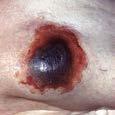
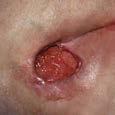
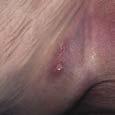

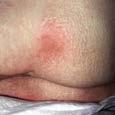
Stage III
Full thickness tissue loss. Subcutaneous fat may be visible, but bone, tendon or muscle are not exposed. Slough may be present but does not obscure the depth of tissue loss.
Unstageable
Full-thickness skin and tissue loss with the base covered by slough and/or eschar. Unstageable until enough slough or eschar is removed to expose the base. Excludes reclassification to stage III or IV following exposure/debridement.
Suspected deep tissue injury
Purple or maroon localised decolourisation of intact skin or blood filled blister. May be preceded by tissue that is painful, firm, mushy, boggy, warmer or cooler as compared to adjacent tissue. Can be difficult to detect in individuals with darker skin. May evolve and become covered by thin eschar.
Wound dressing products should be selected, based on their ability to:3
• Optimise wound healing time
• Manage exudate
• Minimise pain
• Protect the wound, peri-wound, surrounding skin and tissue (e.g.: from shear strain or other injury/ trauma)
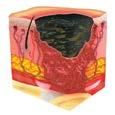


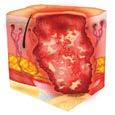


• Control malodour
• Promote autolytic debridement (if required)
• Address bioburden (see Table 1)
Other pressure injury treatments Include: 3
Biological dressings (e.g.: skin substitutes, allografts, collagen dressings)
Growth factors (e.g.: Platelet-rich plasma)
• Biophysical agents (e.g.: electrical stimulation, ultrasound therapy, negative pressure wound therapy)
• Pressure injury surgery (e.g.: surgical sharp debridement or pressure injury excision +/- split skin graft or flap closure)
Although it is dependent on contextual factors for each patient, with effective treatment that includes appropriate local wound care, pressure redistribution, nutrition, and pain management, signs of recovery are usually detected from a reduction in surface area and depth of the wound, decreased exudate, and changes in tissue types.3 Devitalised tissue such as eschar
and slough should be replaced by more healthy regenerative tissue, characterised by granulation and epithelialisation.3 If healing is not occurring according to expectations, a comprehensive reassessment should be conducted. Some patients, such as those undergoing palliative care, can lack the physiological resources to facilitate complete healing of pressure injuries and the goals of care need to be adjusted accordingly (e.g.: to provide comfort, alleviate pain, and address malodour or
3
1. Rodgers K, Sim J, Clifton R. Pressure injury prevalence in Australian & New Zealand hospitals: Systematic review protocol. Collegian [Internet]. 2019 [cited 2021 Mar 1]; 27(4):471-475. https://doi.org/10.1016/j. colegn.2019.11.003
2. Australian Commission on Safety and Quality in Health Care. Australian Commission on Safety and Quality in Health Care [Internet]. Fact Sheet: Preventing pressure injuries and wound management; 2020 [cited 2021 Mar 1]. Available from: https://www.safetyandquality.gov.au/sites/ default/files/2020-10/fact_sheet_-_preventing_pressure_ injuries_and_wound_management_oct_2020.pdf
3. European Pressure Ulcer Advisory Panel, National Pressure Injury Advisory Panel and Pan Pacific Pressure Injury Alliance. Prevention and Treatment of Pressure Ulcers/ Injuries: Clinical Practice Guideline. The International Guideline 2019 [Internet]. European Pressure Ulcer Advisory Panel, National Pressure Injury Advisory Panel and Pan Pacific Pressure Injury Alliance; 2019 [cited 2021 Mar 1]. Third edition. Available from: http://www. internationalguideline.com/
Story-telling has always come naturally to nurse and midwife Liesl Dowling, especially when in comes to telling stories to kids.
With three children’s books published Liesl, who goes by the pen name Dorothy Dowling, is sharing her own experiences in telling stories and the positive effects it has had on her own life.

A culture of story-telling is a crucial part of our society and it is a key tool in educating children. It can also play a profound role in processing the complexities of our own lives, especially in terms of grief. This is no more apparent than in Liesl’s own journey towards writing and publishing her stories.
“I always told stories to my children when they were growing up. It was something I loved doing.” Liesl said.
The stories she told were a personal connection between her and her kids, but it would be a many years before Liesl would think about sharing those stories outside of her family.
It would be impossible to tell Liesl’s story without mentioning her son.
About four years ago Alex died in an accident. He was 17. This, understandably, led to one the hardest times in Liesl’s life and she found her own personal sadness was starting to bleed over into her professional life.
“I really struggled with grief,” Liesl said.
“I was becoming more and more emotionally affected by patients. I was just so affected by others people’s grief and sadness. I needed to inject some good into my life.
“My husband, who is also a nurse, said we needed to find a hobby as a way of processing the grief.”
The spark of change came in the form of a simple question, “what is Chookity Chook?”

What’s in a simple story? Memories, happiness, grief and a way to connect with people.
This question, posed by her husband, was in response to an email mentioning Chookity Chook, one of the stories Liesl told Alex when he was a child.
“My husband suggested I should write it down, but at the time I told him I couldn’t. I said I had forgotten all of it.”
Liesl would do nothing more with the story for a few months, perhaps it simply wasn’t the right time, but clearly the idea stuck. It was waiting for the right moment to blossom.
Then, on a flight to Perth of all things, the moment struck. Her Kindle ran out of battery on the plane and her husband said she should use to time to write something down.
That was that.
“Once I started writing I found I could remember nearly all of it.
“The first story I wrote is really a tribute to Alex. It was a way for me to remember the warm memories, the good things and the funny things. The story meant I could still cry, but be able laugh too. It is a lovely place to be, to be able to put some happiness into the grief.”
This new found happiness had a flow-on effect with her nursing too. For the past three years Liesl has worked in Kununurra, and since she started writing she has increasingly found new joy in her work. Along with nursing and midwifery, Liesl facilitates nursing students in Kimberley and Pilbara for Notre Dame University, another role she enjoys.
“I’m stronger now. Writing has enhanced and complemented my nursing.”
Liesl also said her time working with aboriginal people has also played a part in her writing.
“I’ve worked a lot in aboriginal health over the years. They tell so many stories and they are good at yarning.
“People learn more with stories. Stories are all around us, they just need telling. Having a strong story-telling culture is a great asset. It helps build connections and support a sense of community.
“I write to make kids laugh and to help parents connect with their kids. I’m really passionate about reading to kids. Quality time with kids is really important and reading can be a big part of that.”
Now with three books published, Liesl’s advice to other budding authors is very straightforward; just start writing.
“I turned off the TV and just started. Now, I do it for relaxation. “Self-publishing platforms are also so available now, and at a base level it doesn’t really cost anything.”
Liesl Dowling’s three books Chookity Chook, 12 Unicorns In My Bedroom and Captain Stinky Bot The Fartiest Pirate that Ever Lived are all out now. You can also check out Dorothy Dowling on Facebook and Instagram.



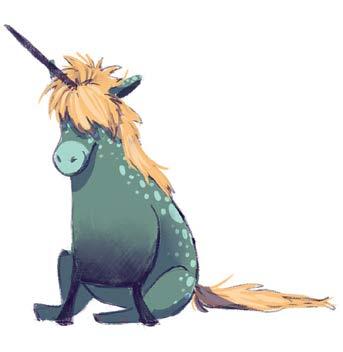
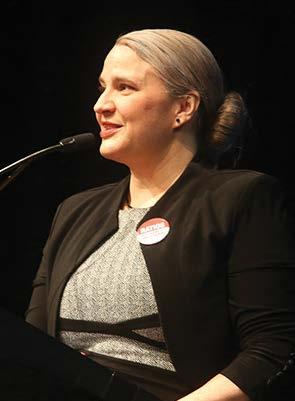

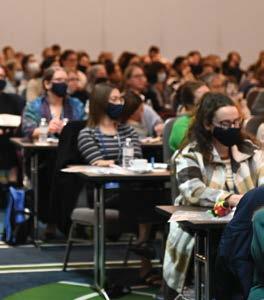

The recent ANF Legal Conference was a huge success, with over 500 nurses attending a day of informative talks on a range of important topics.
The ANF would like to thank all our speakers for taking this opportunity to share their knowledge and experience with members.
Overall, the feedback from members has been very positive. Thanks go to everyone who took the time to let us know their thoughts on the day.
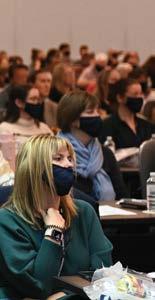



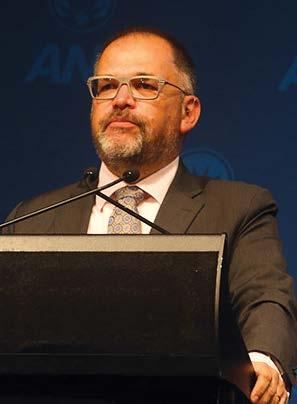



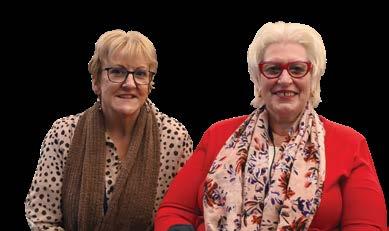



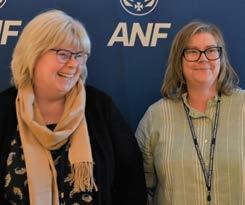
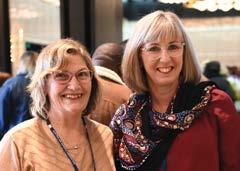
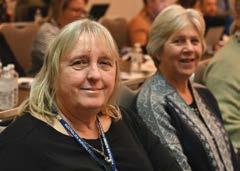
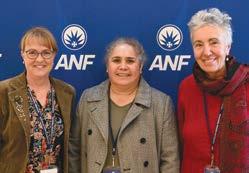
98 % of attendees were satisfied with the overall organisation and logistics of the ANF Legal Conference
86 % of attendees rated the relevance and quality of the topics at the conference as very relevant/high-quality
97 % of attendees found the ANF Legal Conference met or exceeded their expectations
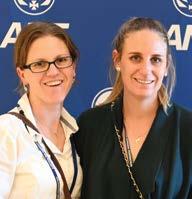

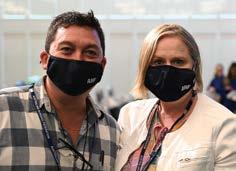
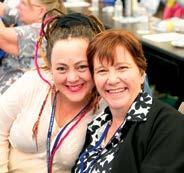
98 % of attendees would recommend the ANF Legal Conference to their colleagues or professional network
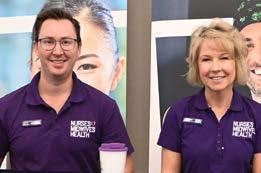
“Excellent, well-planned day. Thank you Janet Reah and the team for organizing such a long-awaited topic. The venue, the food, and speakers, and the content were fantastic. I enjoyed all the presenters and their presentations, all relevant to my work life.”

“I found everything to be fantastic. Such a well organised event.”
“I have learned a lot from the conference. The topics are very relevant to my work in ED. The scenarios given were really true and commonly happening. Took down all the helpful tips. The questions from the audience were also very interesting. I am so glad that we have this kind of union who fights for nurses. Please do conduct more conferences like this. I will highly recommend this to my colleagues.”
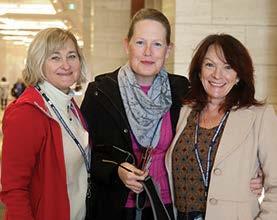
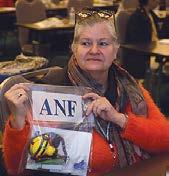
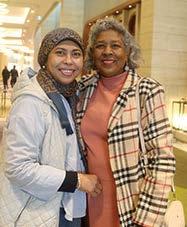
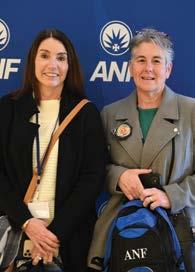
“I thoroughly enjoyed the conference. It was well organised, informative and interactive. The topics were so relevant to practice and interesting. I will be sharing the information with my colleagues at work.”


“It's been a long time since I have been to an education day and learnt so much, every speaker was unique, related their talk to practice and it felt very empowering. In recent times I think everyone has been so burnt out, it was refreshing to walk away feeling hopeful and proud to be a nurse. Again, credit to the speakers. The content was so relevant to practice. I wish more of my colleagues could have attended.”
“Everything was great. I was blown away by the content, the facilities, and catering. It was excellent value for money.”


“The conference exceeded my expectations. Highly recommended. Thank you ANF Team for organising the conference and the hard work you all put in to make it happen! Thank you again.”
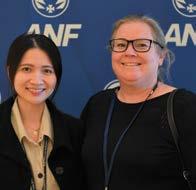
“Overall I thoroughly enjoyed the conference and would like to see a yearly or biannual conference. All the information covered in the legal conference was relevant to all areas of practice.”




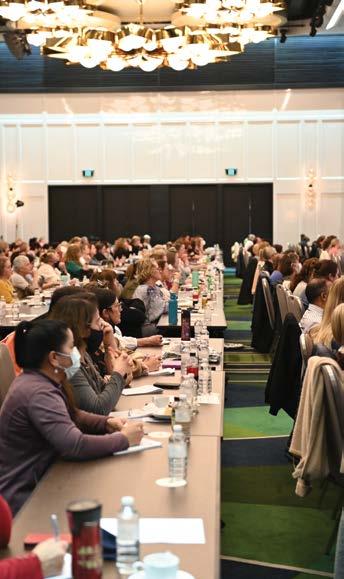
“The conference topics were extremely interesting, answered numerous questions that I had and were very thought provoking. It made me reflect on my own practice and that of my colleagues and some of the directions and statements that are made about duty of care, competency etc. It was also very useful to learn more about the legal representation and assistance that is available through the ANF and reassuring to know the support is there when often it feels like the organisation I work in doesn't listen. Excellent day and I've told everyone who has time to listen that they should also have attended. Thank you.”
“Fantastic presentation and line up of speakers.”

Our highly respected team of lawyers at the ANF Legal Service is available, free of charge, to all ANF members on a range of issues, including but not limited to:
– The death of a patient
– AHPRA complaints
– Unfair dismissals
– Disciplinary investigations
– Civil litigation

– Representation at Coronial Inquiries
Remember: if you think you need a lawyer, you probably do. Don’t hesitate to book a time to talk via Helpline through iFolio.


Following on from the success of the ANF Legal Conference, the ANF Work Health and Safety Conference saw several hundred eager ANF members attend this great event.

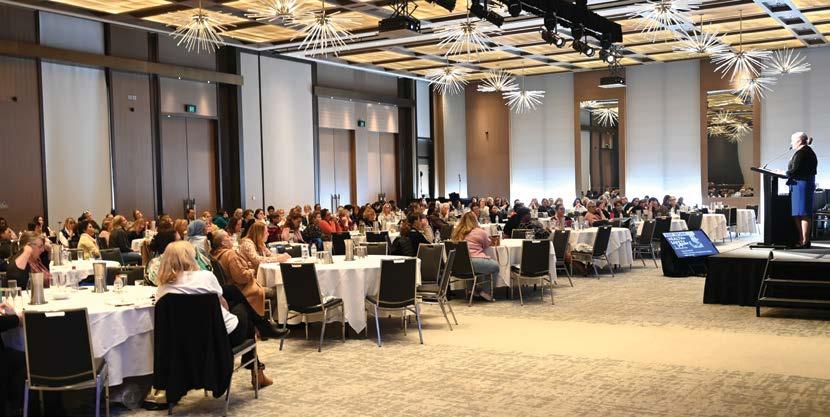
Members heard from a range of speakers on topics including: identifying, reporting and removing workplace hazards; reporting workload hazards; WorkSafe and new OHS laws; the WorkCover scheme; workers compensation; and workers’ rights when returning to work after an injury.
Thanks to all our speakers and to the members who attended.
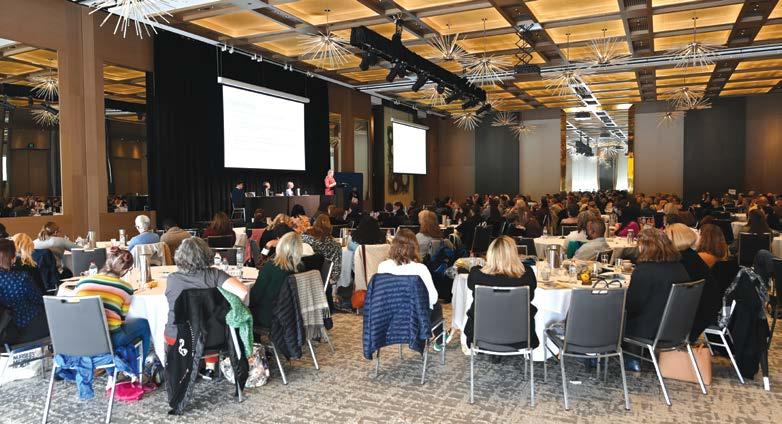




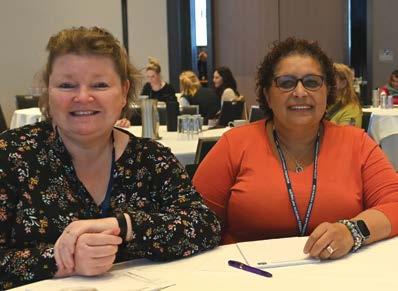


Nearly 100% of attendees were satisfied with the overall organisation and logistics of the ANF WHS Conference
Close to 90% of attendees were satisfied with the relevance and quality of the topics at the conference

Over 90% of attendees found the ANF WHS Conference met or exceeded their expectations





95% of attendees would recommend the ANF WHS Conference to their colleagues or professional network.

“I am looking forward to the next conference. Both this one and the legal conference were great.”


“You were all fantastic and I enjoyed the conference. Thank you for updating IFolio with CPD. I will surely love to attend more ANF conferences. Thank you so much.”

“Thank you for the conference. It was worth travelling to Perth for it.”

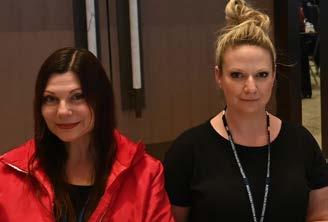
“Really enjoyed it. Thank you.“
“Thank you so much for today’s conference. It was excellent and will definitely come to another the ANF deliver.”
“The conference was great, I really enjoyed all the presentations. Many thanks.”
“Thanks for putting on a great day.”
“Yes it was excellent and I really enjoyed the speakers, some of whom I was fortunate to sit with. Looking forward to the next presentations.”
“Thank you, it was an amazing conference. I look forward to seeing you again.”

“I really enjoyed the conference. It was very informative and I would love to pass the information to my colleagues. Looking forward to the next conference.”

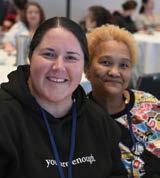
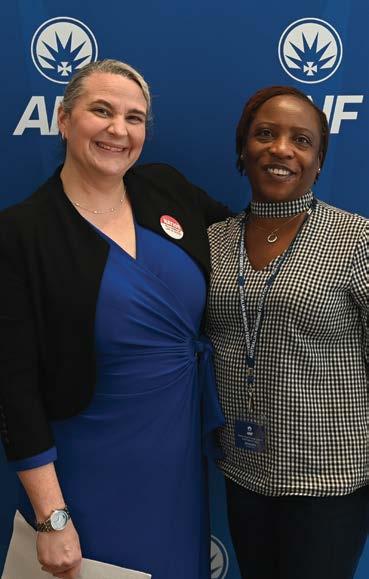
“Speakers after lunch were excellentcertainly prevented the after lunch slump.”


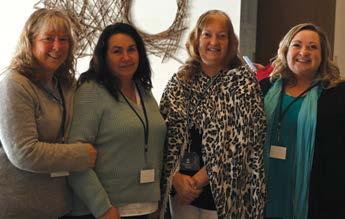
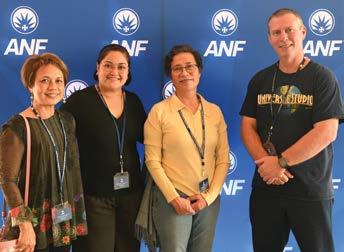
“Having the parking next door was excellent.”
“That was a great seminar.”
“Very well organized! I look forward to any future conferences.”
“Thank you for creating the opportunity for this excellent event.”
“It was a great day, very informative. Thank you and the team for organising the day.”
“I thoroughly enjoyed the one day conference, very informative and relevant. Many thanks.”
“Thank you for a wonderful and very informative day.”
“Thank you and the team for organising the day.”

Our highly trained ANF Industrial Officers are ready to help.
This free service is available to all ANF members for all industrial and professional matters.
We are here to help. Don’t hesitate to book a time to talk via Helpline through your iFolio.

As the number of used Electric Vehicle (EV) batteries in Australia grows, so will the volume of waste, from almost 30,000 tonnes by 2030 to 1.6 million tonnes by 2050, according to a recent report.
The Battery Stewardship Council together with Federal Chamber of Automotive Industries and the Motor Trades Association of Australia has warned that, as the number of used batteries grows, action is needed to ensure infrastructure is in place to recover precious resources and avoid the issues of stockpiling and fires.
Battery Stewardship Council CEO Libby Chaplin said EV batteries present increasing risks and opportunities which the vehicle industry is yet to deal with at scale.
“Investment in EV battery stewardship and recycling infrastructure is immediately needed for industry to avoid costly solutions in the future and miss out on the financial opportunities offered by the recycling of used batteries,” Ms Chaplin said.
“The EV industry is facing a golden opportunity to take the lead in designing a scheme that is cost effective, fit for purpose and avoids the mistakes and costly fall-out of inaction as seen recently by the solar panel industry by prioritising the discussion of end-of-life processes today.”
According to the report there are currently around 100,000 EVs on the road in Australia. Currently fewer than 1,000 tonnes of batteries are reaching their end of life but with the projected growth the volume of used batteries is set to grow exponentially. By 2030 the number of used batteries will grow to almost 30,000 tonnes, over 360,000 in 2040 and 1.6 million tonnes by 2050.
The Therapeutic Goods Administration (TGA) has announced a new policy to reduce in the maximum size of packs for various paracetamol products, in order to reduce potential harm to consumers.
The TGA released a statement saying the new restrictions will come into effect from 1 February 2025 to allow manufacturers and retail outlets time to adjust.
The new restrictions on paracetamol will reduce the maximum size of packs available for general sale from 20 to 16 tablets or capsules and reduce the maximum size of packs available in pharmacies without the supervision of a pharmacist from 100 to 50 tablets or capsules
Other pack sizes of up to 100 tablets or capsules will only be available only under the supervision of a pharmacist.
Paracetamol tablets and capsules will also be required to be in blister packaging. The maximum size of “Pharmacy Only” packs of individually wrapped powders or sachets of granules containing paracetamol will also be reduced in line with tablet and capsule packs.
Access to liquid, modified-release and Schedule 4 paracetamol is not affected by this decision.
“Each year in Australia around 225 people are hospitalised with liver injury and 50 Australians die from paracetamol overdose, with rates of intentional overdose highest among adolescents and young adults. This decision aims to reduce the harm from intentional overdose,” the TGA said in its statement.
To further minimise the harm from paracetamol overdose, the TGA is encouraging retailers, such as supermarkets, to restrict sales to a single pack at a time. The TGA is also encouraging consumers not to stockpile paracetamol in their home and to appropriately store paracetamol and other medicines.
The Australian Government is urging people to be alert to possible scams and to be vigilant with their personal information during tax time.
Assistant Treasurer and Minister for Financial Services Stephen Jones said the Government expects to see heightened scam activity and new tax scams being circulated during tax time.
“Impersonation scams are most commonly seen at tax time. Scammers will impersonate the ATO contacting individuals via a link to a fake myGov login page,” Minister Jones said.
In 2021-22 the ATO received over 20,000 scam reports from taxpayers and has received a similar number of reports in 2022-23.
The public are urged to protect themselves against scammers with a few easy steps:
• remember the ATO will never send you a link to login to their online services or ask you to send personal information via social media, email or SMS.
• report any suspicious contact claiming to be from the ATO to ReportScams@ato. gov.au and Scamwatch.
• delete the suspicious correspondence from your account or block the account on social media
• not respond if any contact seems suspicious. Instead, call 1800 008 540 to check if it was the ATO speaking with you.
While gambling levels dropped across the nation at the height of the COVID-19 pandemic, a study by the Australian National University has found gambling rates in Australia are returning to the same levels as prior to the pandemic.
Director of the Australian National University Centre for Gambling Research and lead author of the study Dr Aino Suomi said the study suggests restricting access to gambling is effective way to reduce gambling rates, and that this is particularly true for those playing poker-machines or betting on sports at low-risk levels.
“This is especially important as we know poker-machines are one of the most addictive forms of gambling,” Dr Suomi said.
“Sports betting and poker-machines are also the forms that have ‘recovered’ the quickest for those individuals who’ve been gambling at risky levels since the pandemic.
“Once lockdown restrictions began to ease, the gambling participation, as well as gambling risk tended to increase across all categories, including non-gamblers.”
Although there was an overall decrease in gambling, high-risk gambling continued during the pandemic, even when access was restricted.
“The important pattern is that those gambling at risky levels were participating in sports betting at disproportionally high levels pre, during and post pandemic,” Dr Suomi said.
Multinational food and drink processing conglomerate Nestle has announced it will no longer produce Fantales, the famous Australian chocolate covered caramel lollies with "fan tales" of actors and musicians on its wrappers.
First created in 1930, the Fantales have spent nearly 100 years on sale in Australia. Nestle slated the end of Fantale production for mid-August following declining sales and a need for significant upgrades to continue production at the Nestlé confectionery factory in Melbourne.
Nestlé Oceania Confectionery General Manager Andrew Lawrey said this is sad news for many people.
“Many of us grew up with Fantales and have fond memories of them. Despite the sense of nostalgia Fantales evoke, unfortunately people simply aren’t buying them as often as they used to,” Mr Lawrey said.
“In addition, our Fantales equipment needs significant investment. It’s become increasingly difficult to get the parts we need to maintain it, and with declining sales, replacing it isn’t viable.”
According to statement released by Nestle, workers on the Fantales production line will move to other roles within the factory. Fantales will be available for sale while stocks last.
Diabetes WA is calling for greater recognition of the impact of diabetes on Aboriginal Communities in Western Australia, with Aboriginal people in Western Australian having a higher risk of diabetes and diabetes-related complications than any other community in the state.
A statement released by Diabetes WA said Aboriginal people in WA are nearly 40 times more likely to have a major lower limb amputated and those living in remote areas are 20 times more likely to experience end stage renal disease compared to the national average.
To combat this situation, Diabetes WA is running an Aboriginal health workforce development pilot scheme, which has
trained 20 Aboriginal health professionals to deliver diabetes education sessions.
Diabetes WA CEO Melanie Gates said training Aboriginal health professionals to work in communities is an essential part of closing the diabetes gap.
“Diabetes is silently impacting generations of Aboriginal families by damaging hearts, kidneys, eyes and feet,” Ms Gates said.
“Aboriginal communities have told us that to close the gap that they want more Aboriginal health professionals involved in diabetes education.”
Diabetes WA states it is committed to mentoring the newly trained Aboriginal Health Professionals and hopes to secure funding to expand the program to meet demand.
The Australian Tax Office has announced it is focussed on three main areas this current tax period: rental property deductions, work-related expenses and capital gains tax.

ATO Assistant Commissioner Tim Loh said these are areas where the ATO often see mistakes being made.
“Within these areas, we have identified common mistakes and are particularly focused on addressing these and supporting taxpayers and registered tax agents to get their claims right this year.”
ATO said it is committed to supporting taxpayers to meet their obligations and said it offers range of resources to help people with their tax.
“We know many people are doing it tough this year. We expect fewer people will receive a refund or may receive smaller refunds than they were expecting, and more may have tax debts to manage,” Mr Loh said.
“If you’re feeling overwhelmed or getting behind with your tax, let us know as early as possible or have a chat with your
registered tax agent so we can work with you to find a solution. Don’t bury your head in the sand.”
The ATO said it is particularly focused on ensuring taxpayers understand the changes to the working from home methods and are able to back up their claims. To claim working from home expenses as a deduction, you can use the actual cost, or the revised fixed rate method, so long as you meet the eligibility and record-keeping requirements.
“There have been some changes in how you calculate things like working from home deductions, so don’t be tempted to just copy and paste your prior year’s claims. We know a lot of people are working back in the office more compared to last year,” Mr Loh said.
For more information visit ato.gov.au/ home
According to an ATO review of income tax returns 90 percent of rental property owners are getting their return wrong. This includes rental income being left out or mistakes with deductions, like over-claiming expenses or claiming for improvements to private properties.
The ATO said it is particularly focused on interest expenses and ensuring rental property owners understand how to correctly apportion loan interest expenses where part of the loan was used for private purposes.
For more information visit ato.gov.au/ rental
The ATO is reminding taxpayers of the importance of keeping records of the income-producing period and the portion of the property used to produce income to calculate your capital gain. Capital gains tax comes into effect when you dispose of assets such as shares, crypto, managed investments or properties.
"Don’t fall into the trap of thinking we won’t notice if you sell an asset for a gain and don’t declare it," Mr Loh said.
For more information visit ato.gov.au/CGT
Research conducted by the University of New South Wales has found stress related to COVID-19 had a greater effect on those who were pregnant during the pandemic than those who were not.
The study collected mental health data on 742 pregnant participants in Australia, Europe and the US during and after pregnancy. The data showed COVID-19 related stress had the greatest impact on pregnant people who had a tendency to worry, felt lonely or had a low tolerance for uncertainty.
Pandemic stress was measured using the “Pandemic Anxiety Scale”, which measures individuals’ concerns about the pandemic, including worries about contracting the virus, having enough food and job-related impacts.
While COVID-19 related stress was associated with more mental health problems in both pregnant women who were who weren’t, Dr Susanne Schweizer from UNSW Science said not all women were affected in the same way.
“There were vulnerability factors, such as lack of social support, increased loneliness, worry and intolerance of uncertainty, which had a greater impact on mental health in the context of pandemic related stress in pregnant women, compared to their non-pregnant counterparts,” Dr Schweizer said.
A follow up study found that feeling stressed about the pandemic during pregnancy not only had a lasting effect on participants’ own mental health, but was also associated with an increase in a negative mood in their infants.
Dr Schweizer argues more support is needed for pregnant people’s mental health as part of standard pregnancy care.
“Pregnancy is a period of vulnerability for mental health problems,” Dr Schweizer said.
“Intense and rapidly fluctuating moods and emotions are a normal part of pregnancy and after birth many people will experience intrusive, unwanted thoughts. Pregnant individuals need to be given information about what to expect, what is common and when they should seek help.”
Dr Schweizer and her team are now looking to develop online educational resources for people to learn about how pregnancy can impact mental health.
associated with lower brain volume and cognitive measures, which affect reaction time and memory.
“Daytime dozing was also associated with some of these indicators of impaired brain health,” Dr Namsrai said.
Over 29,000 people aged between 37 and 73 took part in the study. It is hoped the research may provide some clues in combating diseases like dementia, which affects more than 55 million worldwide according to the World Health Organisation. There is currently no known cure.
“Around 20 to 40 percent of dementia cases are attributable to modifiable, non-genetic factors,” Dr Namsrai said.
“The most well-known of these include smoking, alcohol misuse and obesity. But sleep is an emerging risk factor.”
While issues around sleep may be a further risk factor for dementia, Dr Namsrai said a greater focus on the links between sleep and brain health is needed.
“The mechanisms underlying the link between sleep and brain health are not well understood. There’s a lot of work to be done,” Dr Namsrai said.

“But our study shows it could be an important target if we want to improve brain health into old age and delay the onset of dementia.”
A new clinical trial in Australia will see first-time mothers offered melatonin tablets to reduce the rates of induced labours and mitigate the risk this poses mothers and babies across the nation.
Lead researcher Dr Zoe Bradfield from the Curtin School of Nursing said the trial sought to address an imminent crisis in Australian maternity care.
“The rate of first-time mothers having their labour induced is increasing, with induced labour associated with harm for the mother and the baby as well as contributing to rising health costs,” Dr Bradfield said.
“Melatonin is a hormone produced naturally in the body that can help the start of childbirth.
“Our study will determine whether giving pregnant women oral melatonin from 39 weeks’ gestation may help with starting labour normally in a simple and cost-effective way to decrease induced labours.”
The rates of induced labours among first-time mothers had increased over the past decade, from 32 to 47 percent of all births in Australia.
“The evidence indicates that the induction of labour in the absence of a medical need or complication may actually increase the risk of harm to the mother and baby,” Dr Bradfield said.
Australian National University researchers have found poor sleep in middle age can have a negative impact on your overall brain health. This is not just limited to too little sleep; too much sleep or too many naps may also contribute to the problem.
Lead author on the study Dr Tergel Namsrai said getting more than nine hours of sleep a day or less than six hours a day were both
“As a result, there is growing concern about the rapid rise in the induction of labour before 41 weeks’ gestation for women without medical complications.
“Obstetric intervention in late pregnancy continues to rise without a demonstrated reduction in stillbirth and with a clear increase in earlyterm birth at 37 to 38 weeks, which is known to be harmful to the child’s neurodevelopment.”
The four-year, double-blind clinical trial run through the Women and Newborn Health Services at King Edward Memorial Hospital and Osborne Park Hospital will determine if oral tablets of melatonin 3mg once daily from 39 weeks’ gestation reduces the rate of induced labours.
The trial is a collaboration between Curtin University, the Women and Newborn Health Services, The University of Western Australia, the Hudson Institute of Medical Research, Monash University and King Edward Memorial Hospital for Women.

Scientists at the Australian National University will play major role in the detection of ripples in space and time, known as gravitational waves, with a new facility on campus.
The new ANU facility will act as a remote control room for Laser Interferometer Gravitational wave Observatory (LIGO) in the United States. LIGO is one of the leading gravitational wave observatories on the planet.
According to a statement from the ANU, the new LIGO remote control room is based at the Centre for Gravitational Astrophysics (CGA), the ANU node of the Australian Research Council Centre of Excellence for Gravitational Wave Discovery.
Dr Bram Slagmolen from CGA said the new ANU facility gives scientists the ability to directly engage with the operation of USbased gravitational wave detectors.
“This facility provides real-time information on the performance of the detectors, as well as notifications on detected events,” Dr Slagmolen said.
“Researchers from ANU will be front and centre in LIGO’s latest observing run, helping monitor the detector, respond to any potential finds and troubleshoot any problems.”
According to a statement from the ANU gravitational waves are weak and extremely hard to detect, needing the cataclysmic collapse of a massive star or the merger of two extremely compact objects such as black holes or neutron stars for the waves to be detected on Earth.
However, when detected, these waves allow scientists to study some of the great secrets of the universe, such as the moment the cores of massive stars collapse and the permanent distortion of space-time.
Lilli Sun from CGA said Australian universities and scientists have played a fundamental role in the hunt for gravitational waves for many years.
“The work we are doing here at ANU will provide a more powerful detection mode for gravitational waves than has existed ever before,” Dr Sun said.

The flooding across the Kimberley caused by Ex-Tropical Cyclone Ellie in December 2022 and January 2023 wreaked havoc across the region, damaging vital infrastructure, business and houses. The destruction left many homeless and the effects were felt by many more.

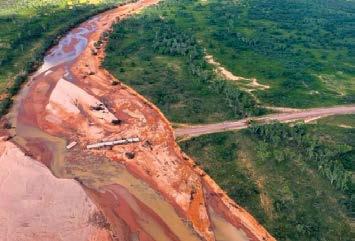
Even now with the disaster recovery and clean-up well underway the effects of the flooding are being felt by many, including the many nurses working to provide healthcare across the region.
Earlier this year the Western Nurse reached out to nurses who were affected by the flooding.
For many, the hardest parts of the disaster was being cut off from supplies and assistance.
Paediatric CN and staff development nurse for east Kimberley Jane Darlington said the flood waters saw Kununurra cut off from Halls Creek and Wyndham hospitals. While the road has since reopened the closure led to a lot of disruptions.
“All our supplies including medications, fluids, dressings normally come from Perth and Broome, which is 1,000km west of Kununurra,” Jane said.
“We rely on road freight and this led to two supermarkets in town running out of fresh food. The cost of local freight tripled in cost and there was little government support.”
With Kununurra cut off, the army and local supermarkets did their best to get fresh food to the area, but this took time.
“It felt very cut off,” Jane said.
It was challenging for hospital staff to organise meals and supply departments. Not only that, but the movement of people was severely hampered across the region, for both staff and patients.
“Staff had to drive to east Kimberley via Adelaide and Katherine. Staff had to allow extra travelling days extra to get in and out of area if driving.
“It was challenging getting patients home and there was an influx of clients staying in towns as they couldn’t get in and out of their communities or because their homes were flooded.
“This led to overcrowding in local housing and increase in domestic violence and alcohol related crime, which led to an increase in emergency department workflow.”
Despite the conditions and an overcrowded ED, Jane said hospital staff have done a fantastic job dealing with a range of issues, including drownings, JEV infections and influenza.
The floods presented some similar challenges for remote area nurse Angela Fisher, based at Wangkatjunkta Health Centre.
“It was like any other wet season until the weather system moved in slowly with large amounts of rain. We kind of knew then that the Kimberley would start to flood. We were quite safe as this community was on high ground. However it flooded all around us, so we were an island,” Angela said.
Angela found the local community was well prepared for the coming isolation as they are used to it, with the most vulnerable people relocated out town prior to flooding.
“I think overall you felt safe at Wangkatjunkta. I did speak to some families in town who described feeling terrified when their houses started to flood and having to run to the shelter. I think it is much harder for them as they have lost everything and have to start again. It is impossible to replace your photographs and other treasured memories.”
Like Kununurra, food and supplies became an issues, and after a few weeks the local community had to be quite resourceful with what was available. Not only that, but the wildlife started presenting some of their own challenges.
“We had an infestation of snakes in the community and we were lucky that no one was bitten but a few people did present who thought they may have been bitten after a close encounter.
Overall the number people presenting with complaints was lower than normal, as there were fewer people in the area, and no visitors.
“This meant we could spend more time with individual cases and try to manage the complexity of the presentations,” Angela said.
“Skin infections were not as bad as I thought they might be. I think people were careful with themselves and their kids. There was quite a bit of respiratory illness however we luckily had no COVID.” Angela did remark that the flooding had created a few opportunities to experience a different mode of transport.
“To be honest I really loved all the helicopters coming in with visiting staff and supplies and evacuating patients some of the time. I did get one ride so I was reasonably happy. My ambition is to get to fly on one of the super CHCS-92s.”
Rebecca Crozier, a Remote Clinical Nurse Specialist working out of the Looma Clinic in the West Kimberley lives on a remote station with her partner and her four year old daughter. Living as remotely as they do, flooding saw them even more cut off than usual, and Rebecca was left with no access to the Looma Clinic.
“Our only access in and out of the station has been by helicopter until recently when our wet season access road to the highway had been repaired. This road goes round the Fitzroy River and is 180km of dirt and 11 gates to the Great Northern Highway,” Rebecca said. Even while cut off, Rebecca still found her skills were needed.
“Being a nurse and living on a remote cattle station is an extremely valuable skill at times! We rely upon RFDS heavily in the wet season but they can only land if our dirt airstrip is dry and safe,” Rebecca said.
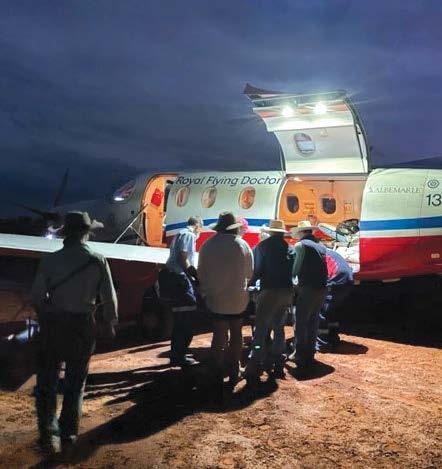
“On the station we have a crew of 12 and working with cattle and horses can be high risk and unpredictable at times. I am often called upon for various ailments with most common being sprains, strains and soft tissue injuries.”
Efforts started off strong with Department of Fire and emergency services stepping into action immediately. Rebecca’s remote station soon found itself to be in the middle of local recovery efforts. “We had the army delivering aviation gas by chinook. Our station was used as a base to deliver hay to neighbouring stations via helicopter as our hay shed was full before the wet,” Rebecca said.
Even with the support it may still be some time before the full effects of the flooding is felt.
“The impact of flooding will be felt for a long time and even when water recedes there are fences, infrastructure to be repaired and stock losses to be assessed. No one will know the true stock loss until their mustering rounds are complete,” Rebecca said.
“We lost some fences and infrastructure, our stock losses are minimal as we always move cattle off river country before the wet as we are always expecting it could be a big one.”
1 Nerve ---, also known as neural blockades (6)
5 Health issue that can be observed (4)
9 Piece of cloth used to cover amissing organ of sight (5)
10 Intensive neonatal care (1,1,1)
11 Outer layer of the eyeball made of fibrous connective tissue (6)
13 Of the anus (4)
15 Arduous trip (4)
16 Tingly sensation, officially known as paresthesia (4,3,7)
20 Lumbago, eg (4)
22 Coastal lake (6)
24 --- connective tissue disease, rare systemic autoimmune condition (5)
25 23rd and penultimate Greek letter (3)
27 German for car (4)
28 Of birth (5)
30 Ring-shaped coral reef (5)
31 Head of a medical journal, eg (6)
33 Mail (4)
35 Procedure to remove amniotic fluid and cells from the uterus for testing or treatment (13)
39 Drug addict (4)
41 Organic compound and the main solid component of mammalian urine (4)
42 Responds to a catalyst (6)
45 Medical preventable adverse effect of care (5)
46 Locks lips with another person, pashes (5)
47 White-dwarf star explosion (4)
48 X-ray pictures, etc (6)
1 Rare genetic disorder causing issues with blood-clotting (1,1,1)
2 Medical cannabis can come in this form (3)
3 Country of paella and chorizo (5)
4 Pigment or dye used in colouring
microscopic objects and tissues (5)
5 excision, simple procedure to remove growths such as moles and lesions (5)
6 by mouth, indication that a patient should have no food, drink or medication taken orally (3)
7 Mark left on the skin after an injury has healed (4)
8 --- disease, inherited red blood cell disorder (6,4)
12 Form of contraceptive (4)
14 Edgar ---- Poe, writer who penned The System of Doctor Tarr and Professor Fether (5)
15 Rulers of old Russia (5)
17 Of or related to an anode (6)
18 Enlarged, as the pupil of an eye (7)
19 Simple non-invasive test that records the electrical activity of the heart (1,1,1)
21 Way out (4)
23 Covid-19 variant (7)
24 Term referring to the final menstrual period (9)
25 It can cause an artery to become narrowed or blocked (6)
26 Mineral needed by the body for growth and development (4)
29 Church table (5)
31 Long period of time (3)
32 Sudden uncontrolled body movement or sound that can be hard to control (3)
34 Attention-getting sound (4)
36 Ruminant stomachs (5)
37 Sign up for a medical course, eg (5)

38 Group of small bones between the main part of the hindlimb and the metatarsus (5)
40 Otic organs (4)
41 Vase to hold the ashes of a deceased person (3)
43 Tooth-like wheel part (3)
44 TV network that aired Interns, a French medical drama (1,1,1)
The Australian Institute of Criminology (AIC) had released a firsttime report on cybercrime in Australia, and it is a sobering reminder of the scale of cybercrime and the number of people affected.
The types of crimes range from large data breaches such as those affecting Optus, MediBank or HWL Ebsworth, to personal abuse and harassment.
AIC acting Deputy Director Mr Anthony Morgan said the report aims to provide a clearer picture of the extent of cybercrime affecting Australian computer users.
The report, based on a survey of 13,887 computer users, delves into online abuse and harassment, malware, fraud and scams, and identity crime. It paints a bleak picture, with a quarter of respondents reporting being negatively impacted by cybercrime.
“In the 12 months prior to the survey, more than a quarter of respondents had been a victim of online abuse and harassment, 22 percent had been a victim of malware, 20 percent had been a victim of identity crime and misuse, and 8 percent had been a victim of fraud and scams,” Mr Morgan said.
A third of respondents said their information had been exposed in a data breach, which increases the risk of becoming a victim of cybercrime. This includes ransomware. Around one in twenty respondents to the survey said they had received a ransom message on their device in the previous 12 months.
The problem is further compounded by low rates of reporting from those affected by cybercrime. Most people don’t report being a victim of cybercrime to police or to ReportCyber.
“Victims of fraud and scams were the most likely to seek help from police or ReportCyber. But our data shows that official statistics significantly underestimate the amount of cybercrime impacting the Australian community,” Mr Morgan said.
“While many people don’t report because they think they could deal with the problem themselves or because it wasn’t serious enough, a large proportion didn’t know where or how to report. We need to make sure people know what help is available and who they can contact when they have fallen victim.
“It is important to act promptly to cyber threats and take the necessary steps to protect yourself from further harm, and to ensure victims of cybercrime are well supported.”
Australian businesses are experiencing an increase in the number of cyber-attacks, the Australian Bureau of Statistics (ABS) reporting 22 percent of businesses experiencing a cyber-attack in the 2021-22 financial year, up from 8 percent in 2019-20.
The types of cyber-attacks included scams or fraud, malicious software infecting computers and unauthorised access or use.
Robert Ewing, head of ABS business statistics, said the new data gives governments and researchers information about the prevalence, impacts and nature of cyber-attacks. The latest figures also show how cyber-attacks impacted businesses and how prepared businesses are for cyber-attacks.
While the number of attacks is increasing, it seems so is preparedness, which means fewer businesses are experiencing negative effects. According to the ABS data in 2021-22 just over half of those that experienced a cyber-attack were negatively impacted, compared to more than 80 per cent of businesses in 2019-20.
“In 2021-22, 34 per cent of businesses reported loss of time in managing cyber security attacks, 18 per cent reported downtime of service, while 17 per cent reported a loss of staff productivity,” Mr Ewing said.
For the first time data was also collected on the types of cyber security measures businesses put in place, with 70 percent reporting at least some form of protection measure.
“Over 60 per cent of businesses reported regular updates to virus protection software,” Mr Ewing said.
“Around 37 percent of businesses regularly backed up operationscritical data, while 20 per cent had identity access management and 13 percent gave staff cyber security awareness training.”
The Australian Government has appointed Air Marshal Darren Goldie AM CSC as Australia’s first National Cyber Security Coordinator.
According to a joint statement issued by the Prime Minister, Minister for Home Affairs and the Minister for Cyber Security the National Cyber Security Coordinator, together with the National Office of Cyber Security “will drive forward the necessary work to ensure Australia is best positioned to respond to the opportunities and threats of the digital age.”
“The Coordinator will lead national cyber security policy, the coordination of responses to major cyber incidents, whole of Government cyber incident preparedness efforts and strengthening of Commonwealth cyber security capability,” the statement said.
“The Coordinator will lead this work in collaboration with the Government’s key policy, operational and security agencies.”
Air Marshal Goldie, who some in the national press have dubbed “Australia’s first cybersecurity tsar” has held various roles in the Royal Australian Air Force over the past 30 years, most recently as Air Commander Australia.
According to the issued statement, as Air Commander Australia he was responsible for “building capability and resilience for the Royal Australian Air Force” as well as leading the coordination of Defence responses to natural disasters and the COVID-19 pandemic.
Air Marshal Goldie also held leadership positions at the Department of the Prime Minister and Cabinet providing strategic foreign policy advice.
If you have been the victim of cybercrime, a scam or a data breach you can make a report online:
Report cybercrime with ReportCyber at www.cyber.gov.au/acsc/report
Report online abuse or harassment with the eSafety Commissioner at www.esafety.gov.au
Report scams via Scamwatch at www.scamwatch.gov.au
If you have been the victim of a cybercrime or data breach contact IDCARE for support at www.idcare.org
The Irish Central Statistical Office has released the results of the Irish census, with data showing the county’s population has exceed five million for the first time in 171 years.
According to the census there were 5,149,139 people in the Ireland on 3 April 2022. This represents an 8 percent increase since the previous census in April 2016.
In 1841, prior to the Great Famine, Ireland had recorded a population of 6.5 million people. From that point on the Irish population continued to decline to its lowest point, recording a population of only 2.8 million people in 1961. Since then the Irish population has been steadily increasing.
For reference the population of Ireland is only slightly smaller than the population of New Zealand.
Authorities in Italy, Germany and Switzerland have arrested 10 suspects believed to be part of an organised crime network involved in smuggling gold and other precious goods, as well as money laundering.
More than 150 police officers across the three nations were involved in the operation, which was further assisted by the European Union Agency for Criminal Justice Cooperation (Eurojust) and the European Union Agency for Law Enforcement Cooperation (Europol).
A statement released by Europol said the network is suspected of laundering over 15 million Euros (a bit over AUD $24 million) through a complex money laundering scheme across Europe.
“Initially, investigators focused on a Greek citizen, who was in contact with an Iranian entrepreneur involved in international gold smuggling and money laundering activities in Italy, Germany, Switzerland and Turkey,” the statement said.
“Overall, the criminal network consisted of 10 Italian, Greek, Turkish and Iranian
nationals operating in the gold industry. They used shell companies to launder illicitly acquired assets through complex money laundering schemes.
“In Zurich, investigators found a room converted into an illegal foundry where gold was melted to hide its illicit origin.”
The small Central American nation of Belize has eradicated malaria following 70 years of efforts to stamp out the deadly disease.
Belize now joins the ranks of 42 countries and one territory certified as malaria-free by the World Health Organization (WHO), including 11 countries in the Americas. Including Paraguay, Argentina and El Salvador, Belize is the fourth country in the Americas and the second in Central America to be certified as free of malaria over the last five years

WHO Director-General Dr Tedros Adhanom Ghebreyesus congratulated the people and government of Belize for this achievement.
“Belize is another example of how, with the right tools and the right approach, we can dream of a malaria-free future,” Dr Tedros Adhanom Ghebreyesus said.
A statement released by the WHO said that over the last three decades, Belize has achieved a dramatic reduction in its malaria burden, from 10,000 cases in 1994 to zero indigenous cases in 2019.
“Belize maintained malaria surveillance efforts during the COVID-19 pandemic and made efforts to integrate malaria and COVID-19 surveillance systems,” the statement said.
Police in Colorado have reported a curious arrest following an otherwise normal traffic stop in the small town of Springfield.
According to a report posted on their Facebook account, the Springfield Police Department stopped a speeding car at around midnight near the town’s main street.
An officer on the scene reportedly saw the man driving the vehicle attempt to swap places with the passenger of the vehicle, who was a dog. The man exited the vehicle via the passenger side door and then claimed he had not been driving, presumably in an attempted to instead incriminate his canine passenger.
According to the Springfield Police Department the man showed “clear signs of intoxication”. The man then attempted to flee the scene when police asked about his alcohol consumption.
According to the report the man made it less than 20 metres from his vehicle before he was stopped by police.
Police subsequently discovered the man was driving from Las Animas to Pueblo and had become lost in Springfield, a small town of only 1,300 people with one main street. It was also discovered that the man had two active warrants for his arrest out of Pueblo.
The dog was not charged.
United Nations Secretary-General António Guterres has called for a renewed international focus on rehabilitation, rather than punishment for minor drug offences, while still working to end drug trafficking.
Tens of millions of people suffer from druguse disorders,” Mr Guterres said.
“Less than one fifth are in treatment. Drug users are doubly victimized: first by the harmful effects of the drugs themselves, and second by the stigma and discrimination they face.
“As a global community, let’s continue our work to end drug abuse, illicit trafficking, and the stigma endured by drug users around the world.”
In a statement released in the lead up to the International Day against Drug Abuse and Illicit Trafficking (also called World
Drug Day), Mr Guterres said people who use drugs can face significant barriers to treatment and health services for infectious diseases like HIV/AIDS and hepatitis, while drug traffickers continue to prey on drug users.
He said the focus on this year’s World Drug Day is on the need to put people first by ending stigma and discrimination and strengthening prevention.
“This means stressing rehabilitation, rather than punishment and incarceration for minor drug offences,” Mr Guterres said This would mean expanding prevention and treatment programmes and health services, while also further cracking down on drug traffickers.
Mr Guterres also stressed the vital role governments across the world play in addressing this issue, referencing his tenure as the Prime Minister of Portugal.
“When I was Prime Minister of Portugal, we implemented non-criminal responses to drug possession for personal use, while cracking down on traffickers and re-allocating resources to prevention, treatment and harm-reduction measures.
“As a result, drug consumption and associated infectious disease rates plummeted, more drugs were seized by police and customs, and — most importantly — lives were saved.
“Today, Portugal has one of Europe’s lowest overdose and death rates from drug use.”

The United Kingdom and Portugal have celebrated the 650th anniversary of the signing of the Treaty of London, the oldest formal alliance between two countries, in what the UK Government described as an “unprecedented milestone in the history of diplomacy.”
The treaty was originally signed on 16 June 1373, forming an alliance between King Edward III of England and King
Ferdinand and Queen Eleanor of Portugal, and committing the two nations to “peace, friendship and alliance”.
A service was held at the Queen’s Chapel in central London where the UK Foreign Secretary James Cleverly, alongside His Majesty The King, the President of the Portuguese Republic and the Portuguese Foreign Minister, celebrated the historic ties.
“The rich history between the UK and Portugal says something special about how we see the world and how our people get along. No other relationship on the planet has survived the test of time as well as ours,” Foreign Secretary Cleverly said.
An original copy of the treaty, which was signed only 20 years after the outbreak of The Plague in Europe, is on display in The National Archive in London.
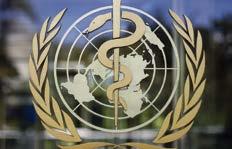
The World Health Organisation (WHO) Council on the Economics of Health for All has delivered report outlining a plan to see world economies to focus on and deliver better health outcomes globally.
The Council was created by WHO DirectorGeneral Dr Tedros Adhanom Ghebreyesus in November 2020 in response to the COVID-19 pandemic and chaired by Professor Mariana Mazzucato.

Staff at the St. Helena Public Library in California received an interesting surprise when a mysterious man returned a book that was 96 years overdue.
The local newspaper, the St. Helena Star, reported the well-worn copy of A History of the United States by Benson Lossing was clearly stamped “Property of the St. Helena Library Association,” and was originally due to be returned to the library on 21 February 1927.
At the time, the mystery man returned the book to the front desk without leaving his name. However, subsequent investigations revealed the man was Jim Perry, who told the intrepid reporters at the Star he had found the hefty tome of history in box of books belonging to his late wife. He also told the Star the book had most likely been checked out by his late wife’s grandfather in 1927.
The Star posited that, applying the library fines of five cents a day for overdue books, the total fine would have come to about $1,756 US, or about $2,690 AUD.
St. Helen Public Library fortunately did away with fines for overdue books in 2019.
The WHO announced the release of the new report and issued a statement saying the council spent last two years “rethinking the economy from a health for all perspective.”
“Two years ago, I asked a team of the world’s leading economists and public health experts – all women – to create a paradigm shift,” Dr Tedros said.
“Now, instead of health for all being seen as the servant of economic growth, we have a roadmap for structuring economic activity in a way that will allow us to reach the goal of seeing all people with access to essential health services faster with better results.”
According to Professor Mazzucato the WHO Council on the Economics of Health for All has worked to “craft a new economic narrative”, which will transform “financing for health from an expenditure to an investment.”
“In our final report, we call for new economic policy that is not about market fixing but about proactively and collaboratively shaping markets that prioritize human and planetary health,” Professor Mazzucato said.
Key recommendations of the report included a fundamental overhaul of national and international systems for financing health, a new end-to-end health innovation ecosystem and a re-investing in government capacity.















The ANF Clinical Reference Cards are the latest feature to be added to the iFolio App following a review update and expansion of the popular cards that was completed last month.
The app version of the cards are even easier to read than before, with the zoom in and out function, and remain a useful tool for the working nurse and midwife.
ANF Secretary Janet Reah says the handy and robust laminated guides have proven popular with members over the last two decades as the range expanded from the original 2 cards in 2003 to current range of 21 that exist today.
“We began a review and update of the cards in August last year which was necessary to ensure the information on them remained accurate, relevant and beneficial to ANF members,” Janet said.
She says once the review was complete the ANF wasted no time getting the updated cards and designs on to the iFolio App as a new feature.
“We are now producing the much loved laminated version as quickly as we can but with over 40,000 members it’s going to take a little while before we have enough for everyone,” Janet said.
The cards, which are still made here in WA, are free to all ANF members and can be ordered using the iFolio.
The process for making the laminated style cards may be time consuming compared to the other plastic reference cards that can be purchased out there but the advantage of the laminated cards is they are robust, last a very long time and the printing does not rub off over time.
As part of the update two new cards now available focus on the topics of “Donning & Doffing PPE” and “Talk Down”. These new cards give great tips with safely applying and removing personal protective equipment and de-escalation when dealing with aggressive patients, both highly relevant issues in working in healthcare.

“These updates are all part of the ANF’s commitment to providing our nurses and midwives with a range of free and simple to use resources and services to help them in their work. The ANF is also in the process of conducting a wider review in to how best to provide CPD and other support for members,” Ms Reah said.
The new and updated cards are already available on the iFolio App and the ANF will be posting out the laminated version to members in the coming months.
The current range of cards includes:




Read this article and complete the quiz to earn 1 iFolio hour
Neutropenia is a low concentration of neutrophils in the blood.1,2 Neutrophils are a type of white blood cell that form the body’s major defence against bacterial and fungal infections.1,2 There are many causes of neutropenia including infection, autoimmune disorders, severe vitamin B12, copper, or folate deficiency, allergy disorders, some drug treatments, enlargement of the spleen, bone marrow disorders, hereditary disorders, and myelosuppressive therapy, such as chemotherapy.1,3
As neutropenia impairs the immune response, neutropenic patients are at a high risk of infection related complications.4 Even a minor infection for neutropenic patients may be life threatening. 5
Febrile neutropenia, also known as neutropenic fever, occurs when a neutropenic patient encounters an infectious pathogen.6 It is defined as a single temperature of 38.5°C or more, or a temperature over of 38°C or more on two sequential occasions within 12 hours, in patients with absolute neutrophil count (ANC) of less than 0.5 x 109/L, or 0.51 x 109/L with a predicted decline in next 48 hours.7,8
Bacteria is the most common infectious organism identified in paediatric febrile neutropenia, however viral infections are also common.9 Fungal infections are often present in prolonged paediatric febrile neutropenia.9
Febrile neutropenia is most commonly encountered in paediatric patients with hematopoietic cancers or who are receiving chemotherapy for cancer.9 The breakdown of mucosal barriers (mucositis) in the gastrointestinal tract and the invasion of commensal microorganisms into the bloodstream is a common consequence of chemotherapy.9
Suspected or confirmed febrile neutropenia is a medical emergency.10 All febrile paediatric oncology patients presenting to the emergency department should be triaged as Australian triage scale (ATS) category two,
and those at risk of imminent cardiovascular collapse as ATS category one.7 All other paediatric patients with suspected or confirmed febrile neutropenia should be triaged as ATS category three.10
When assessing and treating suspected or confirmed paediatric febrile neutropenia it is important to consider non-infectious causes of fever, such as tumour lysis, blood transfusion reaction, dysautonomia with central nervous system (CNS) disease involvement, and drug fever induced by broad spectrum antibiotics or chemotherapy drugs.9
Vascular access
Vascular access through a central venous access device (CVAD) or peripheral intravenous line should be promptly established for blood sampling and antibiotic therapy.7,10
Initial investigations for all patients with suspected or confirmed paediatric febrile neutropenia include:7,10
• Full blood count and differential
• Blood cultures from each lumen of CVAD, or peripheral site if no CVAD access
• Urea electrolytes and creatinine
• Venous blood gas and lactate
• C-reactive protein
• Liver function tests
• Urine microscopy, culture and sensitivity (M/C/S).
The patient’s detailed medical history should also be evaluated including: 5,7
• New site-specific symptoms
• Underlying comorbid conditions, and the phase of any chemotherapy treatments
• Past positive microbiology records, specifically any antimicrobial resistant organisms
• Past infections and non-infectious complications
• Current medications including antimicrobial prophylaxis.
The patient should be classified as a standard or high risk infection.5,7,11 Patients are classified based on clinical criteria, including ANC, expected duration of neutropenia, and the presence of comorbidities (see Table 1). 5,9,11
Some patients are also classified as high risk based on patient characteristics, conditions, or treatments: 7,10,11
• Acute myeloid leukaemia
• Acute lymphoblastic leukaemia
• Infants
• Delayed intensification
• Downs syndrome
• Lymphoma induction therapy
• Neuroblastoma stage IV
• Allogeneic transplant (day -14 to +180)
• Autologous transplant (day -7 to +60)
• Reinduction therapy for any relapse.
Empiric antibiotic therapy should be commenced within 30 minutes of patient arrival.7 Antibiotics should not be delayed while waiting for initial investigation results.7,10
A physical examination should be carefully conducted to find the source of the infection, noting that clinical signs of infection may be subtle due the patient’s impaired ability
to mount an inflammatory response.4,7 The examination should pay particular attention to:7,10
• Skin, particularly bone marrow, lumbar puncture, and other biopsy sites, and nail beds for local infection, cellulitis, or vesicular lesions
• Oropharynx for mucositis, dental abscess, or local infection
• Upper respiratory tract for otitis media or sinusitis
• Lower respiratory tract for signs of pneumonia
• Perineum and perianal area for cellulitis, fissure, or abscess
• Vascular access sites for signs of infection
• Abdomen for signs of colitis, typhlitis, or organomegaly
• CNS for signs of impaired consciousness, meningism, and focal neurological deficits. The patient’s vital signs should also be assessed for:7
• Haemodynamic compromise, such as hypotension, tachycardia, and wide pulse pressure
• Tachypnoea, laboured breathing, or hypoxia.
Fluid resuscitation
Fluid resuscitation is indicated in patients displaying signs of haemodynamic compromise or sepsis.7,10
Supplemental investigations
Additional investigations should be conducted as clinically indicated including:7,10
• For respiratory symptoms – chest x-ray, swab for respiratory virus PCR, sputum for M/C/S
• For diarrhoea – stool for M/C/S, viral studies, and Clostridium difficile toxin assay
• For abdominal pain – abdominal ultrasound
• For skin or mouth lesions – bacterial/fungal swab for M/C/S, or viral swab of mouth ulcers and vesicular lesions for Herpes Simplex Virus and Varicella Zoster Virus PCR
• For CNS signs or symptoms – CNS imaging or lumbar puncture.
All paediatric patients presenting with suspected or confirmed febrile neutropenia should be discussed with the oncology consultant/fellow.7,10
The following assessments should be performed daily:7,10
• Physical examination for signs of an infective focus
• Full blood count
• Blood cultures for patients with ongoing fevers.
A repeat blood culture is also indicated for a change in antibiotic therapy, to confirm or exclude a positive blood culture result, or if there is new onset fever or clinical instability after being afebrile for more than 48 hours.10
For all patients, consider discontinuing empiric antibiotics if there is evidence of marrow recovery, and the patient has negative blood cultures and has been afebrile for at least 24 hours.10 If there is no evidence of marrow recovery and neutropenia is expected to be prolonged, cessation of antibiotic therapy may be considered if blood cultures are negative, the skin and mucous membranes are intact, and there are no planned impending invasive procedures or ablative chemotherapy.10
For low-risk patients, consider discontinuing empiric antibiotics at 72 hours if the patient has negative blood cultures and has been afebrile for at least 24 hours, irrespective of marrow recovery status, if careful follow-up is ensured.10
If febrile neutropenia is prolonged (lasts more
than 72 hours) or recurrent, investigations for invasive fungal infection should be considered including:10
• CT of lungs and sinuses for children aged over two, and targeted imaging of other clinically suspected infection sites10
• Bronchoscopy and lavage (BAL) if pulmonary infiltrates detected on CT of lungs10
• Fungal cultures from blood, BAL, and other sites as indicated10
• Galactomannan on blood and BAL fluid.10
The recommended empiric antifungal agent is amphotericin.10
1. Healthdirect Australia. Healthdirect [Internet]. Neutropenia; 2020 [cited 2021 Feb 22]. Available from: https://www.healthdirect.gov.au/neutropenia
2. Neutropenia. 2020 [cited 2021 Feb 22]. In: MSD Manual Professional Version [Internet]. Kenilworth (NJ): Merk Sharp & Dohme Corp. Available from: https://www.msdmanuals.com/en-au/ professional/ hematology-and-oncology/leukopenias/neutropenia
3. Coates TD. Overview of neutropenia in children and adolescents. 2020 [cited 2021 Feb 22]. In: UpToDate [Internet]. Waltham (MA): UpToDate Inc. Available from: https://www.uptodate.com/ contents/overview-of-neutropenia-in-children-andadolescents
4. Zimmer AJ, Freifeld AG. Optimal Management of Neutropenic Fever in Patients with Cancer. J Oncol Pract [Internet]. 2019 [cited 2021 Feb 22];15(1). doi: 10.1200/JOP.18.00269
5. Caffrey MK editor. Guidelines in the Management of Febrile Neutropenia for Clinical Practice. Perspectives in Febrile Neutropenia Care: Evidenced-Based Oncology [Internet]. Cranbury (NJ): American Journal of Managed Care; 2017 [cited 2021 Feb 22]. Available from: https://www.ajmc.com/view/guidelines-in-themanagement-of-febrile-neutropenia-for-clinicalpractice
6. Punnapuzha S, Edemobi PK, Elmoheen A. Febrile Neutropenia. 2020 [cited 2021 Feb 22]. In: StatPearls [Internet]. Treasure Island (FL): StatPearls Publishing LLC. Available from: https://www.ncbi.nlm.nih.gov/ books/NBK541102
7. Government of Western Australia Child and Adolescent Health Service. Perth Children’s Hospital Guideline: Fever and Suspected of Confirmed Neutropenia: Empiric Guidelines [Internet]. Perth (Australia): Government of Western; 2020 [cited 2020 Dec 8]. Available from: https://pch. health.wa.gov.au/-/media/Files/Hospitals/PCH/ General-documents/Health-professionals/ChAMPGuidelines/Febrile-Neutropaenia.pdf?la=en
8. Febrile neutropenia. 2020 [cited 2021 Feb 22]. In: eTG Complete [Internet]. Melbourne (Australia): Therapeutic Guidelines Limited. Available from: https://tgldcdp-tg-org-au/ viewTopic?topicfile=febrile-neutropenia&guidelineNa me=Antibiotic&topicNavigation=navigateTopic
9. Davis K, Wilson S. Febrile neutropenia in paediatric oncology. Paediatr Child Health [Internet]. 2019 [cited 2020 Dec 08];30(3):93-7. doi: 10.1016/j. paed.2019.12.002
10. The Royal Children’s Hospital Melbourne. Clinical Practice Guidelines [Internet]. Fever and suspected or confirmed neutropenia; c2020 [cited 2020 Dec 08]. Available from: https://www.rch.org.au/ clinicalguide/guideline_index/Fever_and_suspected_ or_confirmed_neutropenia
11. Children’s Health Queensland Hospital and Health Service. Guideline: Management of Fever in a Paediatric Oncology Patient [Internet]. Brisbane (Australia): State Government of Queensland; 2019 [cited 2021 Feb 22]. Available from: https://www. childrens.health.qld.gov.au/wp-content/uploads/ PDF/guidelines/gdl-fever-oncology.pdf
The ANF offers informative talks on topics relevant to contemporary nursing and midwifery, all for free.


Places are available on a range of topics: Coroners Court: Learn more about coroners' investigations including discussions on the role of the coroner, the inquest process, evidence gathering, being a witness, making statements and other legal considerations surrounding coroners' reports.
Documentation: A handy refresher on the importance of proper documentation, best practices for record-keeping, legal requirements for documentation and how to maintain accurate and comprehensive records.
Social Media: Take part in discussions around potential legal issues that can arise from its use including privacy concerns, defamation, intellectual property infringement, professional boundaries and ethical considerations when using all types of online media platforms.
Discrimination: This talk covers the legal framework surrounding discrimination, including laws, regulations and case precedents, with reference to the various forms of discrimination, such as gender, race, age, or disability and provide guidance on how to prevent and address such issues in professional settings.
Defamation: Defamation involves making false statements that harm someone's reputation. We explain the elements of a defamation claim, how to minimize the risk of defamation in the context of the workplace, defences against defamation and the potential consequences of defamatory statements on your registration and your wallet.
Workers’ Compensation: This session covers the essentials that all members must know about the Workers’ Compensation process and how to make it work for you rather than your employer if you are injured at work.
ANF Job Rep Training 1: This important information is useful for all members, not just Job Reps, and covers the process of resolving group issues at your workplace.